The Giant Earthworm Museum
The bigger version should appear when you click a picture. Your next click, on a different picture or anywhere else, will close it.
No javascript? The picture will open in a new window.
Please click the browser back button to return here.
Dean took many of these pictures and I scrunched them down mercilessly.
In case you're wondering, that's the stick of a lollypop that Alex has protruding from his mouth in two of the pictures.
An Enforced Change of Plans
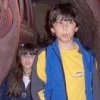 Visiting this place was almost an accident. We've passed it often enough but haven't ever felt particularly excited about what might be inside. You've seen one earthworm, giant or otherwise, and you've seen them all. Perhaps you haven't though, tried to imagine how the world must seem to an earthworm, or made your way on hands and knees through twisting tunnels. The tunnel the children are walking through in this picture was designed for adults, so there was plenty of head-height. The red lighting helped create a bit of atmosphere. Another tunnel was definitely for crawling through, and very short parts were completely dark. Anyway, I'm getting ahead of myself.
Visiting this place was almost an accident. We've passed it often enough but haven't ever felt particularly excited about what might be inside. You've seen one earthworm, giant or otherwise, and you've seen them all. Perhaps you haven't though, tried to imagine how the world must seem to an earthworm, or made your way on hands and knees through twisting tunnels. The tunnel the children are walking through in this picture was designed for adults, so there was plenty of head-height. The red lighting helped create a bit of atmosphere. Another tunnel was definitely for crawling through, and very short parts were completely dark. Anyway, I'm getting ahead of myself.
We'd planned to spend Thursday exploring rock pools on Phillip Island. The weather report wasn't encouraging, but the sky was blue, so off we went.
 As we drove the sky darkened, and by the time we arrived it was blowing a gale. We had just enough time to get out of the car and put on jackets before the rain started. Back we headed for Cowes, where we proposed to find shelter and eat lunch. Somehow we'd missed packing our sandwiches, so Trina, Alex and Dean went to buy food and Jen and I, since the rain had stopped, went walking along the beach with the wind behind us. How foolish! The wind wasn't at our backs as we returned! Jen and I took shelter against the retaining wall and did our best to get the sand out of our clothes. We did have a small piece of fruit cake and some biscuits, so we shared those rather stingily with the gulls.
As we drove the sky darkened, and by the time we arrived it was blowing a gale. We had just enough time to get out of the car and put on jackets before the rain started. Back we headed for Cowes, where we proposed to find shelter and eat lunch. Somehow we'd missed packing our sandwiches, so Trina, Alex and Dean went to buy food and Jen and I, since the rain had stopped, went walking along the beach with the wind behind us. How foolish! The wind wasn't at our backs as we returned! Jen and I took shelter against the retaining wall and did our best to get the sand out of our clothes. We did have a small piece of fruit cake and some biscuits, so we shared those rather stingily with the gulls.
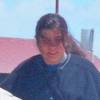
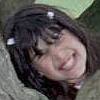 As the others arrived back from their shopping expedition the rain began again; just a mist at first, but accompanied by an increase in the wind. Trin was almost blown over as she strode towards us with pies, juice and lollypops. We gave up the idea of searching out a built shelter. We wanted to be close to the car in case of a downpour! Dean and Trina coped with the drizzle; the children and I found a group of sturdy trees. When she saw that I was going to take a picture, Jen ran around behind a twisted trunk and, just at the right moment, popped her head up at a funny angle and with an enormous grin. She'd obviously decided to have fun and enjoy the day no matter what.
As the others arrived back from their shopping expedition the rain began again; just a mist at first, but accompanied by an increase in the wind. Trin was almost blown over as she strode towards us with pies, juice and lollypops. We gave up the idea of searching out a built shelter. We wanted to be close to the car in case of a downpour! Dean and Trina coped with the drizzle; the children and I found a group of sturdy trees. When she saw that I was going to take a picture, Jen ran around behind a twisted trunk and, just at the right moment, popped her head up at a funny angle and with an enormous grin. She'd obviously decided to have fun and enjoy the day no matter what.
All I could think about was getting away from this wind-scoured island, so, grasping at the first thing I thought of, I suggested we have a look at the giant earthworms. No-one was enthusiastic, but something's usually better than nothing. We did expect to see the living giants, but that expectation was unfulfilled. It turns out that the Giant Gippsland Earthworm has become an endangered species—the usual habitat destruction story, of course—so people can no longer take a spade into the bush and drag home specimens willy-nilly. We did see a few very large earth-filled glass tanks in which the captive worms were living, and their tunnels were evident, but only glimpses could be had of the actual animals.
Click a roo for a wider view!
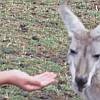
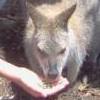 There were plenty of other creatures, though, and while I can't seriously accept the name Wildlife Wonderland, the animal park has some appealing features, the best of which is that you're allowed to touch and feed the animals. The small size of the place makes this possible. Keepers can see what every visitor is doing and make certain that only the approved food—a lolly-bagful for 50 cents—is used. Alex told me later that most of the kangaroos and wallabies had absolutely no interest in the food, but with dozens of visitors feeding them each day I suppose they can afford to be stand-offish.
There were plenty of other creatures, though, and while I can't seriously accept the name Wildlife Wonderland, the animal park has some appealing features, the best of which is that you're allowed to touch and feed the animals. The small size of the place makes this possible. Keepers can see what every visitor is doing and make certain that only the approved food—a lolly-bagful for 50 cents—is used. Alex told me later that most of the kangaroos and wallabies had absolutely no interest in the food, but with dozens of visitors feeding them each day I suppose they can afford to be stand-offish.
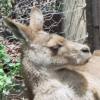
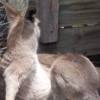 They certainly seem happy and confident, and they have a fair amount of space. This mother and baby were supremely indifferent to visitors, cameras and offers of food. The joey seemed to know exactly where his food was coming from, anyway. It's funny that we mostly think of roos leaping over the plains. In fact, given the opportunity, they seem to prefer to graze quietly, hopping a step or two now and then, or just lie about.
They certainly seem happy and confident, and they have a fair amount of space. This mother and baby were supremely indifferent to visitors, cameras and offers of food. The joey seemed to know exactly where his food was coming from, anyway. It's funny that we mostly think of roos leaping over the plains. In fact, given the opportunity, they seem to prefer to graze quietly, hopping a step or two now and then, or just lie about.
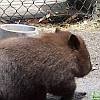
 I was surprised and a bit bothered when I first saw wombats in what seemed to be small enclosures. Later I saw a notice concerning road-kill orphans. It seems that these people take those orphans who have “failed the course” in places where they're supposed to be made suitable for release. If a little wombat has decided that it likes people, and—more to the point—has come to depend on them for food, it can't be successfully released; it would perish.
I was surprised and a bit bothered when I first saw wombats in what seemed to be small enclosures. Later I saw a notice concerning road-kill orphans. It seems that these people take those orphans who have “failed the course” in places where they're supposed to be made suitable for release. If a little wombat has decided that it likes people, and—more to the point—has come to depend on them for food, it can't be successfully released; it would perish.
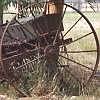
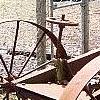 The whole place is much more like someone's farm come private pet park than like a modern zoo. To add to that feeling, there were two beautiful old pieces of farm machinery. I have no idea what they are or how they were once used. Riding between those iron wheels must have been bone-jolting, but aren't the machines graceful in themselves? Makes you think of Bert Facey's “Fortunate Life”. Inside, of course, there are the usual amenities, including light refreshments and a place to buy souvenirs.
The whole place is much more like someone's farm come private pet park than like a modern zoo. To add to that feeling, there were two beautiful old pieces of farm machinery. I have no idea what they are or how they were once used. Riding between those iron wheels must have been bone-jolting, but aren't the machines graceful in themselves? Makes you think of Bert Facey's “Fortunate Life”. Inside, of course, there are the usual amenities, including light refreshments and a place to buy souvenirs.
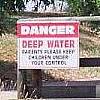 Another thing reminiscent of a farm was this dam. "Danger. Deep Water," reads the notice, "Parents, please keep children under your control". Perhaps not quite as deep as a farmer might wish, though! There wasn't a lot of labelling. There were helpful and informative notices where appropriate, but not all animals were named. Maybe it's impractical—many move around pretty freely. Whatever, it means I just don't know what some of the creatures are called.
Another thing reminiscent of a farm was this dam. "Danger. Deep Water," reads the notice, "Parents, please keep children under your control". Perhaps not quite as deep as a farmer might wish, though! There wasn't a lot of labelling. There were helpful and informative notices where appropriate, but not all animals were named. Maybe it's impractical—many move around pretty freely. Whatever, it means I just don't know what some of the creatures are called.
 The koalas that we saw sleeping in trees were the Queensland ones. They appear to be smaller and their ears don't seem as prominent. This man was carrying one of the more familiar Phillip Island type, though. There really did seem to be a fondness between them, which surprised me. I've never been overly partial to koalas—and my grandmother told me they're “no good in the pot,” either. The name koala is supposed to mean “no drink”. Nevertheless, I saw pans of water under most of the inhabited trees.
The koalas that we saw sleeping in trees were the Queensland ones. They appear to be smaller and their ears don't seem as prominent. This man was carrying one of the more familiar Phillip Island type, though. There really did seem to be a fondness between them, which surprised me. I've never been overly partial to koalas—and my grandmother told me they're “no good in the pot,” either. The name koala is supposed to mean “no drink”. Nevertheless, I saw pans of water under most of the inhabited trees.
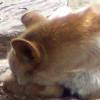
 The few dingos were also unfamiliar to me. Dingos I've met previously have been golden all over, excepting a few white hairs in the tail-tip. These blokes looked smaller, softer and more rounded—and they were very good at sleeping! Dingos aren't quite native Australians. They came with the first humans, thousands of years ago. They can interbreed with modern dogs, too. The disappearance of large carnivorous marsupials from the mainland is probably largely due to competition from the dingo.
The few dingos were also unfamiliar to me. Dingos I've met previously have been golden all over, excepting a few white hairs in the tail-tip. These blokes looked smaller, softer and more rounded—and they were very good at sleeping! Dingos aren't quite native Australians. They came with the first humans, thousands of years ago. They can interbreed with modern dogs, too. The disappearance of large carnivorous marsupials from the mainland is probably largely due to competition from the dingo.
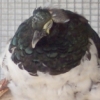
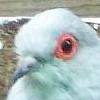 Here are two of my unknown birds. The big dark one has a face rather like that of a pigeon, but he's big and round and has lots of fluffy feathers. The little blue and grey one is very like a dove, but so pretty! I don't even know whether these birds are Australian. There were quite a few exotics about the place.
Here are two of my unknown birds. The big dark one has a face rather like that of a pigeon, but he's big and round and has lots of fluffy feathers. The little blue and grey one is very like a dove, but so pretty! I don't even know whether these birds are Australian. There were quite a few exotics about the place.
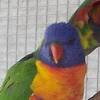 There can be no doubt that rainbow lorikeets are locals. Flocks of six to ten often visit eastern Melbourne gardens looking for nectar or ripe fruit. They're native in the north and east, but have also been introduced into the Perth area, where some people aren't entirely happy about their behaviour in orchards. There's quite a lot of information about this bird at the Australian Wildlife web site.
There can be no doubt that rainbow lorikeets are locals. Flocks of six to ten often visit eastern Melbourne gardens looking for nectar or ripe fruit. They're native in the north and east, but have also been introduced into the Perth area, where some people aren't entirely happy about their behaviour in orchards. There's quite a lot of information about this bird at the Australian Wildlife web site.
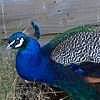
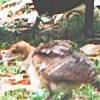 Hera's chariot was pulled by peacocks and when her beloved servant the hundred-eyed Argus was killed, she put his beautiful eyes into the peacock's tail—or so the story went. It's amazing though to see how wonderfully camouflaged the chicks are. They were pecking around in a patch of fallen leaves and were hard to see even up close. No wonder hawks need to have such keen eyesight!
Hera's chariot was pulled by peacocks and when her beloved servant the hundred-eyed Argus was killed, she put his beautiful eyes into the peacock's tail—or so the story went. It's amazing though to see how wonderfully camouflaged the chicks are. They were pecking around in a patch of fallen leaves and were hard to see even up close. No wonder hawks need to have such keen eyesight!
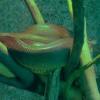
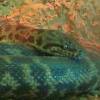
 Here are a couple of characters from the red light district—snakes are illuminated with red light so they'll feel that it's dark and be more likely to move around. Another reptile was this tortoise with the delightfully clownish face.
Here are a couple of characters from the red light district—snakes are illuminated with red light so they'll feel that it's dark and be more likely to move around. Another reptile was this tortoise with the delightfully clownish face.
Friday was warm, fine and sunny with no wind: a perfect beach day. Ah well, perhaps in a week or two.
Information
I haven't covered everything that we saw. The park and museum are open from 10:00 a.m. to 5:00 p.m. daily.
The park is on the South Gippsland Highway, on the way to Phillip Island. From the road you see a pinkish model of an earthworm—on your right as you travel from Melbourne.
Questions or comments? I’d love to hear from you. My email address is here.
Return to top
January 2004